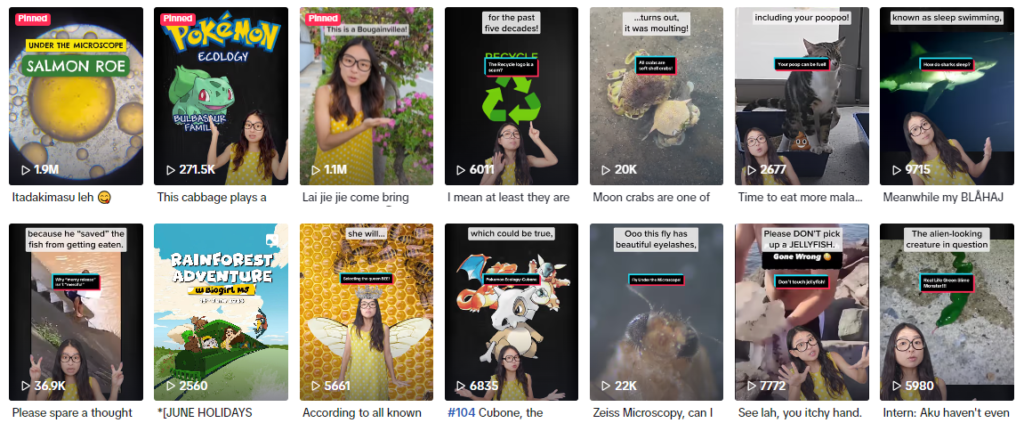
“Hi guys!” This is the signature opener of Kong Man Jing, a teacher-turned-content creator making science accessible. Her bespectacled face takes up the entire screen in 9:16 aspect ratio before the reel cuts to reveal she is once again wearing a yellow polka-dot dress. The fast-talking host raps out science facts in laymanized language while captivating visuals change and shift. The reels she hosts at Just Keep Thinking get as much as 3M views globally.
What science fact they’ll learn the next day is a point of curiosity to her 500,000+ followers, but to science communicators, the larger question is this — what’s the secret to telling impactful science stories in 60 seconds or less?
Just Keep Thinking’s Approach
While some channels cater to those already well-versed in science, MJ’s approach is designed to educate the completely uninitiated.
“Our target audience is really anyone who’s not the least bit interested in such thing or is clueless of what’s going on,” she says.
Interestingly, only 16% of the public follows science and tech news “very closely”. That percentage stayed under 18% since 2000, suggesting a need to engage the broader public.
With this audience in mind, the key to Just Keep Thinking’s success lies in striking a balance between entertainment and education.
“If it doesn’t interest them, then you lose the audience,” MJ says, speaking to how social media is designed for short attention spans and endless scrolling.
Millions of posts are published every day and only those that capture attention from the get-go keep the audience engaged.
The videos seem purely entertaining, but educational elements get sneakily woven in, MJ explains.
By cleverly packaging complex concepts into digestible narratives, Just Keep Thinking expands science’s reach to audiences who might otherwise remain disengaged.
Families, aunties, uncles, kids, even elderly folks tune in, drawn by the channel’s ability to demystify the world through a relatable lens.

Steps & Strategies to Science Storytelling
Here’s how Just Keep Thinking produces science reels.
1. Pre-Production Stage
Every reel starts with an idea, often sparked by MJ’s keen observations of the world around her, from insects found in sealed foods to the sweltering heat during a heatwave.
She maintains a running list of topic ideas, fueled by internet trends, pop culture, conversations, and everyday occurrences that foster broad relatability.
Once, someone asked her how she comes up with so many topics. “I also asked myself that at the beginning, but I realized there’s a lot of questions around you. The world is just so big,” she answers.
Once a topic is selected, MJ develops an audiovisual (AV) script, with one column for the narration and another for visual assets. Extensive research is conducted at this stage, with references listed at the bottom of each script.
Afterwards, she has her videographer co-founder, who comes from a non-scientific background, review drafts. He trims overly technical sections and injects more fun, ensuring the content resonates with mainstream audiences.
“Getting a second set of eyes to look through it is very important,” MJ states.
2. Production Stage
With a home studio setup, MJ films multiple videos at once using a phone mounted on a gimbal. She wears her signature thick, black-rimmed glasses and yellow polka dot dress for brand recall and starts rolling.
By the end she has roughly three videos ready to edit.
This technique is called “content batching” which is the act of creating a lot of content in one go. It is often used by content creators and marketers to maximize time.
Behind her, a green screen is set up. This enables the video editor to insert engaging visuals, such as viral animal videos, memes, or quirky motion graphics during post-production.
3. Post-Production Stage
While MJ handles the on-camera portions, she leaves the editing to her co-founder and team, recognizing their expertise in this area.
“I do it in 5 hours. You can do it in an hour,” she says with full trust in her team.
Strategic scheduling also plays a crucial role in the content strategy, with a mix of topics from climate to biodiversity published six times a week to maintain audience engagement.
“We try to have a good mix of all the videos so that it doesn’t bore people,” MJ explains.
Staying attuned to trending conversations allows Just Keep Thinking to release timely and relevant content, maximizing its impact. As a heat wave sweeps over Asia, they released a reel explaining the science behind it. The reel blew up despite the technical jargon.
Building a Recognizable Brand, Accidentally
One of Just Keep Thinking’s most distinctive brand assets — MJ’s signature yellow polka dot dress and glasses — emerged organically from personal style preferences combined with smart design choices.
“An avatar cannot be changing clothes all the time, so it needs to be consistent. That’s where we had to lock down a look,” MJ says, recalling a time when they needed an avatar to represent the brand in infographics.
Since yellow was MJ’s favorite color and she already owned the yellow polka dot dress, that outfit became the base look for the avatar. The glasses were a later addition inspired by personal branding.
Many personalities have an iconic look that they’re known for: Bruno Mars with the fedora, Steve Jobs with the black turtleneck, or that one creator with a mic on a fork. MJ wanted to have that one defining element, too.
“Singapore has the highest myopic rate. So I was like, you know what? Let’s wear specs,” MJ shares.
The ensemble soon became an instantly recognizable trademark as MJ maintained the uniform over years of videos and appearances.
When she’s not donning this nerdy look, people are quick to take notice. “They call me and ask ‘Where is your yellow dress? This is not you!’” MJ laughs. “This is how ingrained the image is. It’s really funny.”
Fans worldwide even reached out inquiring about how many polka dot dresses she owns or whether or not her specs are real.
MJ underscores the importance of curating a coherent brand identity that resonates with the audience.
“I had a vision of myself being that annoying friend or one annoying neighbor who likes to talk about science. I want to be that kind of character when people watch me, so they don’t see me as someone lecturing them.”

Science Communication is the New Cool
With her ingenious approach to science storytelling, MJ has not only captured the hearts and minds of audiences worldwide but has also paved the way for a new era of social media-driven science communication.
By seamlessly blending education and entertainment, Just Keep Thinking proves that even the most complex concepts can be made accessible, engaging, and downright binge-worthy.
Quotes are lightly edited for readability.
